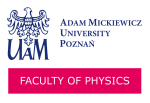Strongly correlated bosons and fermions
Optical lattices provide an excellent framework for studying many-body Hamiltonians, which are difficult to replicate in solids due to their complexity and lack of control over various parameters. The Bose-Hubbard model (BH), which contains a quantum phase transition between two ground states: the superfluid state and the Mott insulator state, is a staple of the study of strongly correlated systems in low temperatures, and its various iterations have lately been under particular scrutiny in relation to optical lattices interacting bosons and fermions confined in optical lattice.
The experimental confirmation of the Bose-Einstein condensation led to enormous progress in analysis of quantum many body systems confined in different geometries and lattice configurations. This triggered the research in the directions previously unknown or not considered in standard condensed matter physics. Also, the extensions of the standard Hubbard model has been revealed within the contemporary experimental setups providing new interesting phases of matter as a super solid, pair superfluid, twisted superfluid…
On the other hand the discovery of short coherence length superconductors, led to the local pairs theories of superconductivity, more resembling bosonic superfluids. Particularly interesting, in this regard, are Extended Attractive Hubbard (EAH) model , hard-core Bose Hubbard Model and Boson-Fermion (BF) models intensively studied in the context of high Tc superconductivity in cuprates and other non-conventional superconductors, and co-developed by prof. Micnas from our Department. The paradigmatic Boson-Hubbard (BH) model of strongly correlated itinerant charged bosons was also motivated by short coherence length superconducting systems (with disorder).
Today, systems of strongly correlated, bosons and boson-fermion mixtures are large, important and intensively studied area of quantum many-body theory. Theoretical progress made in this field lead to better understanding of nature of the interactions between basic constituents of exotic materials with specific properties designed on quantum level. This kind of design will be the future of new quantum engineering.
Our research, we studied:
Bose-Hubbard model in 2D an 3D vs experiment
- A.S. Sajna, T. P. Polak and R. Micnas, ”Conductivity of strongly correlated bosons in optical lattices in an Abelian synthetic gauge field”, Phys. Rev. A 89, 023631 -1-12 (2014)
- A.S. Sajna, T. P. Polak and R. Micnas, ”Conductivity of strongly correlated bosons in the simple cubic lattice- magnetic field and hopping anisotropy effects”, Acta Physica Polonica A 127, 448-450 (2015).
- A. S. Sajna, T.P. Polak, R. Micnas and P. Rozek ”Ground-state and finite-temperature properties of correlated ultracold bosons on optical lattices”, Phys. Rev. A 92, 013602-1-11 (2015).
- A. S. Sajna and R. Micnas, “The effect of boson on-site repulsion on the superfluidity in the boson-fermion-Hubbard model”, Phys. Rev. A 97, 033605-1-13(2018);
- A. S. Sajna, T. P. Polak Phase diagrams and Hofstadter butterflies in the strongly correlated bosonic systems on the lattices with Dirac points”, Annals of Physics393, (2018).
- dr Adam S. Sajna, UAM Poznan´ 2017, ”Phase diagrams and dynamic properties of strongly correlated lattice bosons and Bose-Fermi mixtures”.
- A. Krzywicka, T. P. Polak, „Entropy of pair condensed bosons at finite temperatures in optical lattices with bond-charge interaction”, Journal of Magnetism and Magnetic Materials, (2021).
Boson-Fermion model:
- R. Micnas, ”On the Boson-Fermion resonant model on a lattice”, Philos. Mag. 95, Nos. 5-6, 622-632 (2015),The Focus Issue: From Correlations to Unconventional Superconductivity. arXiv:1912.04094 [cond-mat.supr-con].
Problem of spin polarized superfluids:
- A. Kujawa-Cichy and R. Micnas, ”Stability of Superfluid Phases in the 2D Spin-Polarized Attractive Hubbard Model”, EPL (Europhysics Letters) 95, 37003-1-6 (2011).
- A. Cichy and R. Micnas, ”The Spin-Imbalanced Attractive Hubbard Model in d = 3: Phase diagrams and BCS-BEC crossover at low filling”, Annals of Physics 347, 207-249 (2014).

